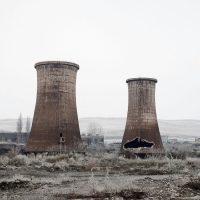All this serves his aim to renew society. This can be felt on his recent series made in Romania, exhibited now in Várfok Project Room. On his photos, usual weekdays sway out of real space and time, get perspective and become the carriers of universal values.
This is where the strength of Tamas Dezso?s work comes from, hence he is capable of seeing the beauty in the shape of an obscure and mouldering factory building, the transformation of a dirty rubbish dump into abstract colour spots due to a flock of birds flying over it and the tenderness of a Madonna in an ordinary, crusty-faced old countrywoman.
Spiritual tradition and physical heritage are simultaneously disintegrating in Romania. Time is beginning to undermine centuries-old traditions preserved in tiny villages, in communities of only a few houses, as well as the bastions of the communist era?s enforced industrialisation, which became part and parcel of Romania?s recent history. Those living in the reservations of forgetting blend with nature, exhibiting a humility inherited through generations. Urged on by modernisation, they are living out their last days in evident equality of closeness to nature and, helping time, they are diligently pulling down the absurd edifices of their environment. In the manner of termites, they carry away small pieces of immense concrete constructions on the rickety carts of poverty, pick through reinforced concrete frames of former factory monsters, power stations and furnaces, dismantling monuments of formerly enforced modernisation which have corroded into a stage set. One year ago, I began photographing the scenes of a world irreversibly decaying, the transformation of a Balkan country surviving the region’s hardest dictatorship. When capturing the still recordable milieu I am examining the parallel of a general tendency and personal stories: as resilient humanity condensing into symbolic destinies takes shape in the face of mortality.
Tamas Dezso
Should the scenes show burrials, poor people living in distress or destroyed villages, it is not the sense of tragedy that will seize one looking at Dezso?s photos. The compositions? pure picturesqueness, their noble aesthetics of an extreme preciseness will rather influence the viewer, releasing in him such feelings and impressions which can only be interpreted on a metaphysical plane.



